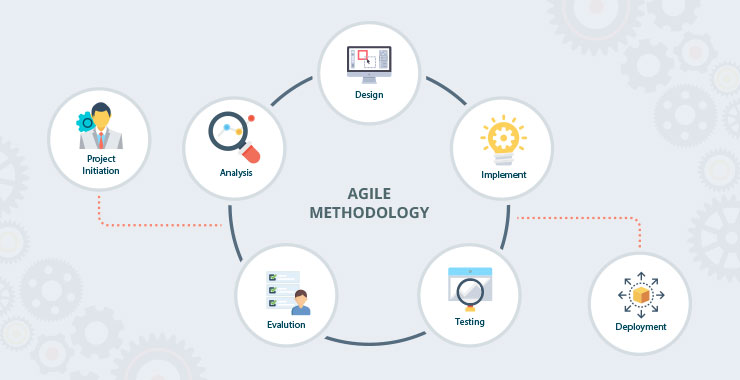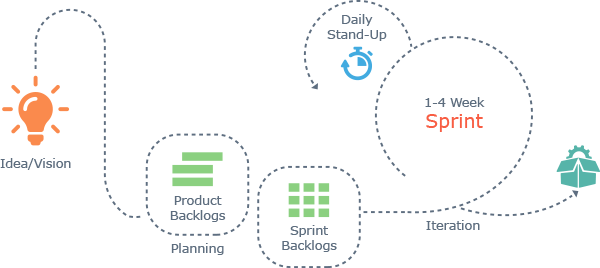Table of Contents
Rushing Product Development? – Things To Know About Software Development Methodologies

As challenging as creating and prioritizing a product development, selecting the software development methodology, you will use to handle it may be more challenging. Even though every software development methodology ensures that the software meets all its requirements, each software has its own set of unique pros and cons. It will help you think twice before rushing a product development process. So here is a definitive guide to the latest and most popular software development methodologies we operate with to help you choose better. Let’s dive in!
Agile software development methodology

Agile is the creation of 17 tech mavens and their Agile Manifesto. It is a widely popular software development methodology that emphasizes adaptive planning, evolutionary development, and continued enhancement over flexible response modifications. The final goal is prompt software release with a lesser risk of bugs or errors.
Pros:
- It’s an adaptive methodology that reacts to the alterations in requirements speedily and efficiently.
- Receiving continuous feedback diminishes significant risks later on.
- Constant communication develops transparency between the team and the client.
- It concentrates on working with software, which means there is minimal documentation to be concerned about.
Cons:
- Increased or altering scope and the absence of focus can be an issue if the brief is vague.
- A lack of documentation can grow the risk of miscommunication.
Scrum development methodology

This development methodology is best suited for quick-changing projects with close neck deadlines. It is intended for teams comprising three to nine members, who divide their work into chunks to finish within a set time, generally two weeks. Daily, the team evaluates its progress in stand-up review meetings called Daily Scrums.
Pros:
- It hustles up the entire development process and is capable of bringing slow-paced projects back on track.
- Decision-making is majorly in the development team’s hands, who put effort at their own pace towards completion. It enables them to be attentive and increases motivation.
- It’s flexible, which permits regular changes and updates.
- A daily scrum meeting helps the managers to measure the extent of individual productivity. It also enhances productivity and collaboration among the team members.
Cons:
- It is apt for small, fast-paced projects but maybe not appropriate for more significant projects.
- This methodology requires an experienced team who are working close by to each other. Having trainees and time zone variations could push back the project delivery dateline.
- Team members must possess comprehensive skills that enable them to work on tasks apart from their specialization area. Sometimes a couple of team members might need extra training.
- Splitting the product development into short sprints needs comprehensive and careful planning.
Dynamic systems development model methodology
This methodology has its origins in the RAD model. It’s an iterative approach that focuses on continuous improvement and abundant user participation. Instead of focusing only on software development and coding, it tags along with project management and project delivery. It is the main reason for its frequent usage for non-technical projects. Its foremost aim is to offer the product or service on time and inside the budget range.
Pros:
- Users are very much involved in the development process just to get an impression of the software ahead of schedule.
- Better-quality, transparency, and incremental development help to minimize risk factors.
Cons:
- DSDM is quite expensive to implement as it needs ten plus dedicated roles, in addition to regular testing
- It isn’t apt for smaller organizations owing to more number of roles wanted.
How to choose the right methodology?
While deciding on a methodology isn’t tranquil, a little study and planning can go a long way. Bring together your list of strengths and weaknesses of your team. Look into which methodologies can complement your team’s capabilities and working style. Finally, filter down your options further by associating which models would serve your projects and clients best.
You may even try out a few of these methodologies on an experimental basis, which is easier for some than others. Over time, you’ll find out which methodology or combination of the works aptly for your team.
Final Thoughts
Often, companies rush into product lifecycle development and wish to crack a challenge right away. It is more like yesterday is better. While Product Lifecycle Management can enable the impact of enterprise-wide development, a hurried description of what should be solved and a correspondingly hasty decision on the solution to help those processes will not work for you in the long run.
Give some thought about the product data interconnectivity. Experience your data in a point of reference or try it on a live system. Then, after you make a choice, continually put the solution to the test. Quickly implement the main objective, place it in the users’ hands to test, and make incremental improvements to get the most of the ROI. Use innovative ideas as much as you can to counterpart your competitive edge.
Despite everything, the solution must serve you, and not the opposite way around. Wish to know more about product lifecycle management software, reach out to our experts. For inquiries regarding the project, development drop us an email at contact@topsinfosolutions.com.
Tags